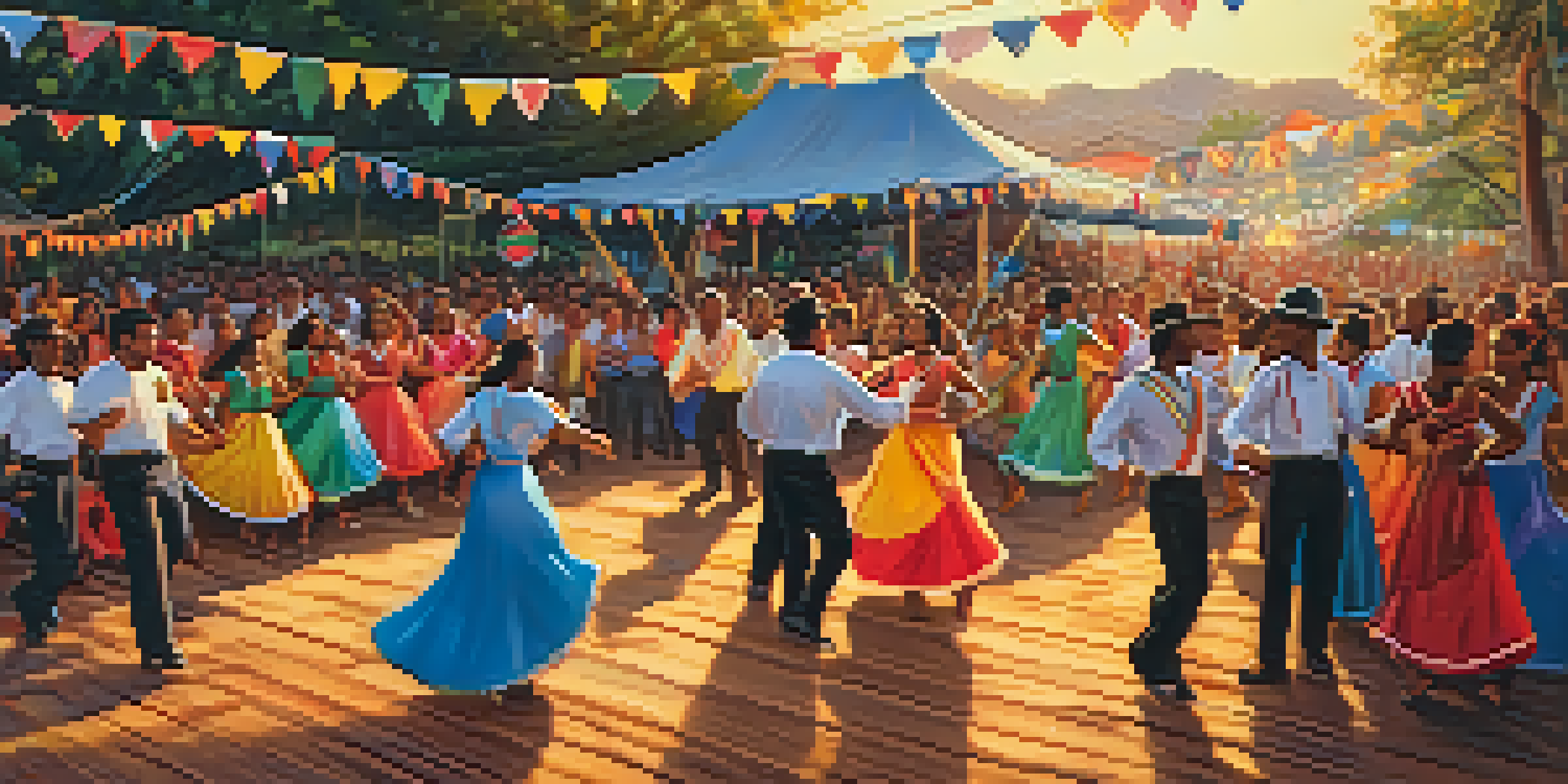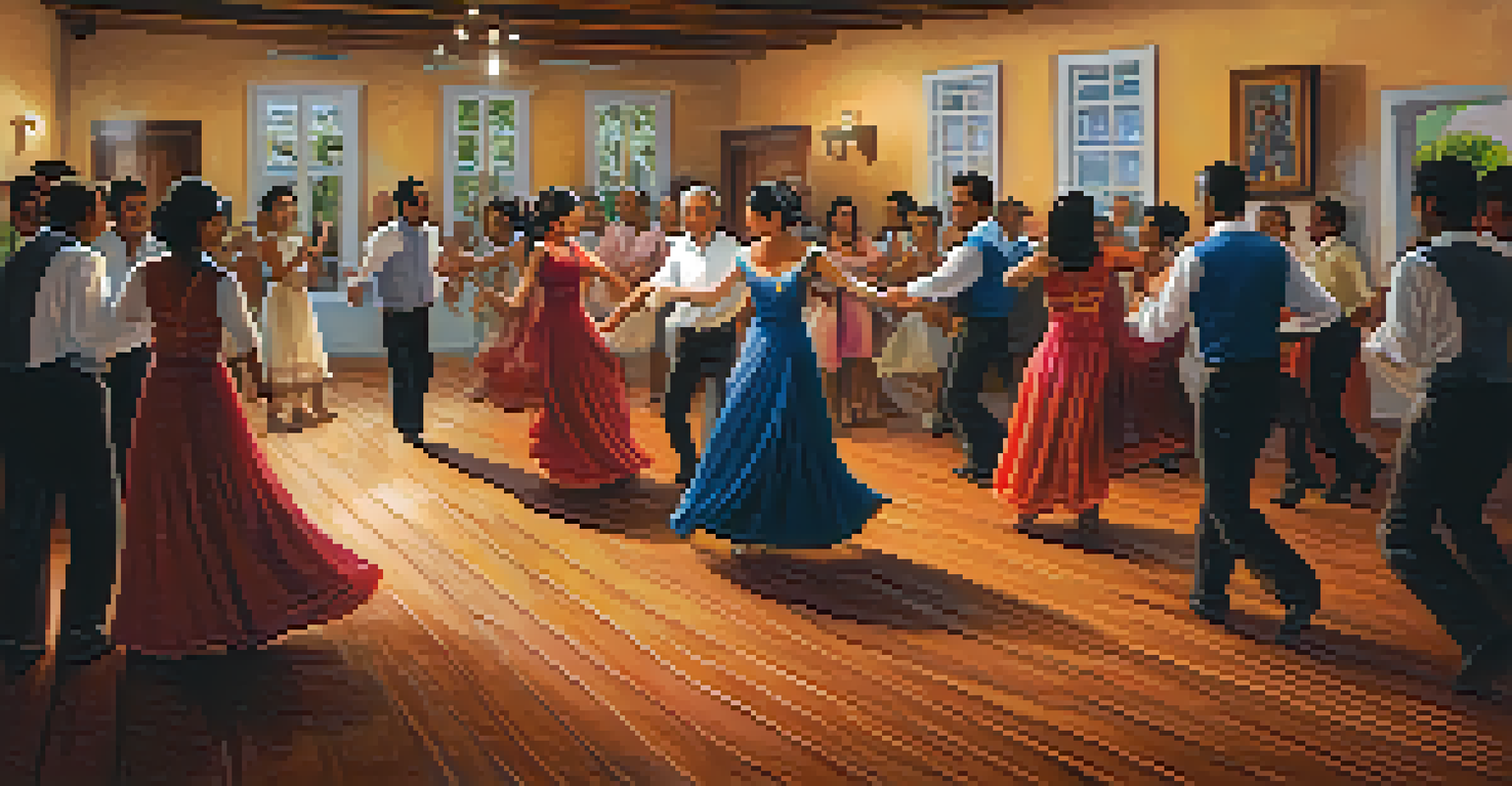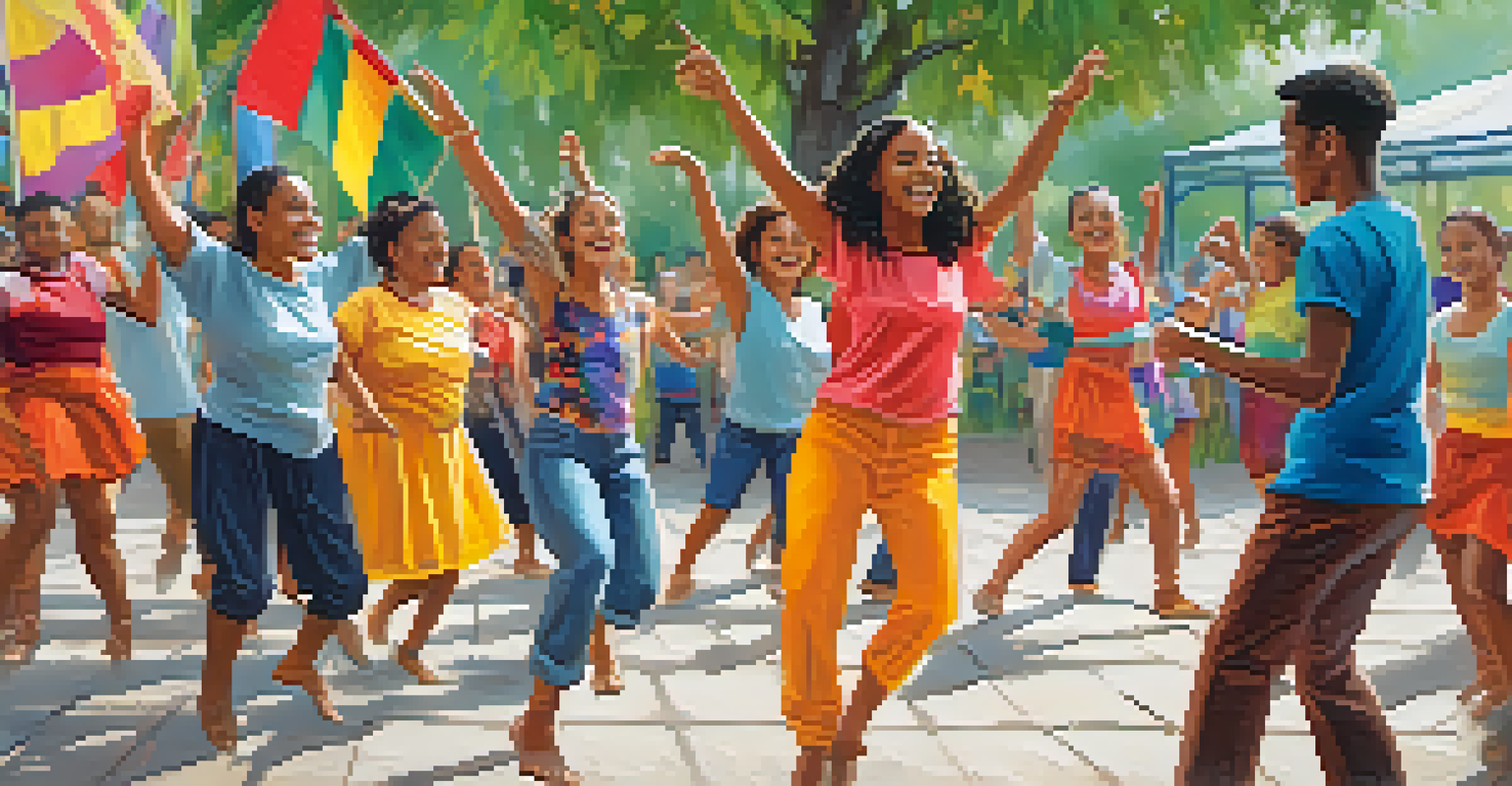Exploring the Regional Variations of Forró Music and Dance

The Origins of Forró: A Cultural Melting Pot
Forró music and dance have deep roots in Brazil, blending influences from Portuguese, African, and Indigenous cultures. This fusion creates a rich tapestry of sounds and movements that reflect the country's diverse heritage. Interestingly, the word 'forró' is believed to derive from the English phrase 'for all,' showcasing its inclusive nature since its inception.
Forró is not just a dance; it's a celebration of life, a way to connect with others through rhythm and movement.
Historically, forró emerged in the rural Northeast of Brazil, particularly during the late 19th century. As communities gathered to celebrate harvests and festivals, the music became a staple, bringing people together through rhythm and dance. Over the years, it has evolved, adapting to various regional styles while retaining its core essence.
Today, forró is not just a genre but a cultural expression, symbolizing unity and joy. The vibrant gatherings in small towns and cities reflect the communal spirit that has defined forró since its beginnings. Understanding its origins provides a deeper appreciation for the regional variations that have developed across Brazil.
Exploring the Northeastern Forró Style
Northeastern Brazil is the heartland of forró, where the music is characterized by its lively beats and traditional instruments like the accordion, zabumba, and triangle. This style often features faster tempos, inviting dancers to showcase energetic footwork and intricate spins. It's common to hear the infectious sounds of forró at local festivals, where everyone joins in the celebration.

A quintessential aspect of Northeastern forró is the 'xote,' a slower, romantic dance that allows couples to connect intimately. Meanwhile, the 'arrasta-pé' is a lively dance that encourages improvisation, showcasing the dancers' creativity and skill. This regional specificity contributes to the vibrant atmosphere, ensuring that no two dances are ever the same.
Forró: A Cultural Fusion
Forró music and dance blend Portuguese, African, and Indigenous influences, reflecting Brazil's diverse heritage.
What makes Northeastern forró truly special is its deep connection to the local culture and folklore. Many songs tell stories of love, hardship, and the rural way of life, resonating with the audience on multiple levels. Thus, the Northeastern style remains a powerful vehicle for cultural expression and community bonding.
The Influence of Forró in Southeastern Brazil
As forró made its way to Southeastern Brazil, it began to blend with other musical styles like samba and bossa nova, creating a unique fusion. This adaptation has given rise to a more urban interpretation of forró, with a slightly slower tempo and intricate arrangements that appeal to city dwellers. The vibrant nightlife in cities like São Paulo and Rio de Janeiro has embraced this evolved forró, making it a popular choice for dance clubs and social gatherings.
Music is the shorthand of emotion, and forró captures the essence of joy and togetherness.
In the Southeastern style, the accordion still plays a vital role, but additional instruments, such as guitars and percussion, often join in, enriching the sound. The dance styles have also evolved, incorporating movements inspired by other genres, leading to a more diverse and dynamic dance experience. This evolution showcases how forró can adapt while still honoring its roots.
Cultural events in the Southeast often feature forró alongside other Brazilian music, creating a melting pot of sounds. This blending allows new generations to experience and appreciate forró, ensuring its relevance in contemporary Brazilian culture. As a result, Southeastern forró is a testament to the genre's versatility and enduring appeal.
Forró and the Southern Brazilian Influence
In Southern Brazil, forró takes on a different flavor, often incorporating elements from regional folk music, such as gaucho rhythms. Here, the dance is characterized by a strong emphasis on partner connection, with movements that are both graceful and grounded. This regional interpretation of forró highlights the importance of storytelling through dance, as each movement conveys emotion and intent.
In the South, the music often features traditional instruments like the bandoneon, which adds a distinct sound to the forró experience. The slower pace and melodic lines allow for more expressive dancing, transforming the dance floor into a canvas for creativity and connection. Dancers in this region often adapt their styles, mixing influences from other folk traditions to create a vibrant dance culture.
Regional Variations of Forró
Forró evolves across Brazil, with distinct styles in the Northeast, Southeast, and South, each showcasing unique rhythms and dance forms.
Additionally, forró in the South is often performed at cultural festivals that celebrate the region's heritage. These events foster a sense of community, drawing participants from various backgrounds to share in the joy of dance and music. This melding of traditions illustrates the adaptability of forró, showcasing its ability to resonate with diverse audiences.
Forró's Global Reach: International Variations
As forró gained popularity beyond Brazil, it began to influence and inspire musicians and dancers worldwide. In countries such as France, the United States, and Portugal, forró has been embraced, leading to unique interpretations and adaptations of the genre. This global reach highlights forró's universal themes of joy, connection, and celebration.
Many international forró dancers have incorporated local styles into their performances, creating a fusion that remains true to the spirit of forró while adding new dimensions. For instance, in France, dancers often blend forró with contemporary dance styles, resulting in innovative performances that captivate audiences. This cross-cultural exchange enriches the dance experience and fosters a sense of community among practitioners.
Workshops and festivals dedicated to forró are now common in various countries, allowing enthusiasts to learn from skilled practitioners. These events create spaces for cultural exchange, where individuals can come together to celebrate their love for forró, regardless of their background. As forró continues to evolve globally, it remains a cherished expression of cultural identity and shared joy.
The Role of Technology in Modern Forró
Modern technology has played a significant role in the evolution of forró, particularly through social media and streaming platforms. These tools have made it easier for musicians to share their work and for dancers to connect with one another, regardless of geographical boundaries. This accessibility has contributed to the resurgence of interest in forró among younger generations.
YouTube, for example, is filled with tutorials and dance challenges that introduce new audiences to forró. This digital presence not only preserves traditional styles but also encourages innovation, as dancers experiment with new moves and interpretations. The result is a thriving online community that fosters creativity and collaboration, ensuring forró's continued relevance.
Forró's Global Influence
As forró spreads internationally, it inspires unique adaptations and fosters a sense of community among dancers worldwide.
Moreover, live-streamed events and virtual dance classes have become popular, allowing enthusiasts to participate in forró from the comfort of their homes. This adaptability showcases how the genre can evolve while maintaining its core values of connection and celebration. Technology thus serves as a bridge, linking generations and geographies through the joyful rhythm of forró.
Celebrating Forró: Festivals and Community Events
Forró is celebrated throughout Brazil, with numerous festivals dedicated to this beloved genre. Events like the 'Festa Junina' and 'Forró do Crato' showcase the best of forró music and dance, drawing locals and tourists alike. These festivals are vibrant celebrations of culture, featuring live performances, dance competitions, and culinary delights that reflect the spirit of forró.
Attending a forró festival is a unique experience, where the air is filled with laughter, music, and the infectious energy of dancers. Participants often dress in traditional attire, honoring the cultural roots of forró while embracing the joy of the moment. The sense of community at these events is palpable, as strangers become friends through shared rhythms and movements.

In addition to large festivals, local forró gatherings in bars and community centers play a vital role in keeping the tradition alive. These intimate settings allow dancers to connect more personally, fostering relationships and camaraderie. Whether at a grand festival or a cozy dance night, forró continues to be a source of joy and connection for people of all ages.